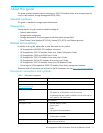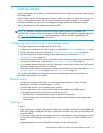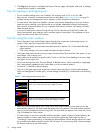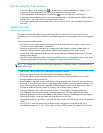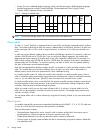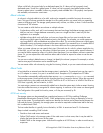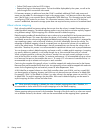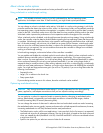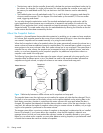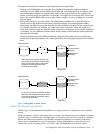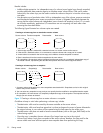HP StorageWorks 2000 G2 Modular Smart Array Reference Guide 17
When a disk fails, the system looks for a dedicated spare first. If it does not find a properly sized
dedicated spare, it looks for a global spare. If it does not find a properly sized global spare and the
dynamic spares option is enabled, it takes any properly sized available disk. If no properly sized spares
are available, reconstruction cannot start.
About volumes
A volume is a logical subdivision of a vdisk, and can be mapped to controller host ports for access by
hosts. This type of volume provides the storage for a file system partition you create with your operating
system or third-party tools. The storage system presents only volumes, not vdisks, to hosts. A vdisk can have
a maximum of 128 volumes.
You can create a vdisk that has one volume or multiple volumes.
• Single-volume vdisks work well in environments that need one large, fault-tolerant storage space for
data on one host. A large database accessed by users on a single host that is used only for that
application is an example.
• Multiple-volume vdisks work well when you have very large disks and you want to make the most
efficient use of disk space for fault tolerance (parity and spares). For example, you could create one
very large RAID-5 vdisk and dedicate one spare to the vdisk. This minimizes the amount of disk space
allocated to parity and spares compared to the space required if you created five or six smaller RAID-5
vdisks. However, I/O to multiple volumes in the same vdisk can slow system performance.
When you create volumes you can specify their sizes. If the total size of a vdisk's volumes equals the size
of the vdisk, you will not have any free space. Without free space, you cannot add or expand volumes. If
you need to add or expand a volume in a vdisk without free space, you can delete a volume to create free
space. Or, you can expand the vdisk and then either add a volume or expand a volume to use the new
free space.
You can use a volume's default name or change it to identify the volume's purpose. For example, a volume
used to store payroll information can be named Payroll.
You can create vdisks with volumes by using the Provisioning Wizard, or you can create volumes manually.
About hosts
A host identifies an external port that the storage system is attached to. The external port may be a port in
an I/O adapter in a server, or a port in a network switch. Examples of I/O adapters are FC HBAs.
The controllers automatically add hosts that have sent an
inquiry command or a report luns command
to the storage system. Hosts typically do this when they boot up or rescan for devices. When the command
from the host occurs, the system saves the host ID. The ID for an FC or SAS host is its WWPN. The ID for an
iSCSI host is typically, but not limited to, its IQN.
You must assign a name to an automatically added host to have the system retain it after a restart. Naming
hosts also makes them easy to recognize for volume mapping. A maximum of 64 names can be assigned.
The Configuration View panel lists hosts by name, or if they are unnamed, by ID.
iSCSI host security
The storage system can be protected from unauthorized access via iSCSI by enabling Challenge
Handshake Authentication Protocol (CHAP). CHAP authentication occurs during an attempt by a host to
login to the system. This authentication requires an identifier for the host and a shared secret between the
host and the system. Optionally, the storage system can also be required to authenticate itself to the host;
this is called mutual CHAP.
The host node identifier is typically, but not limited to, its IQN. A secret can have 12–16 characters.
Steps involved in enabling CHAP include:
• Decide on host node names and secrets.
• Define CHAP entries in the storage system. If the node name is a host name, then it may be useful to
display the hosts that are known to the system.
• Enable CHAP on the storage system. Note that this applies to all iSCSI hosts, in order to avoid security
exposures.





